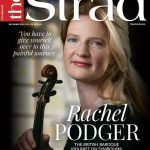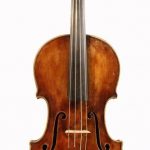Giuseppe Lecchi was born in Felizzano, Piedmont, on 20 August 1895. The son of a woodworker, he graduated from the ‘art and craft’ school in Alessandria, also in Piedmont. In 1915, at the age of 20 he was recruited into the Italian infantry, serving on the front line at the Austrian–Italian border. Returning home from the Great War in September 1919, he began work as a cabinet maker in Felizzano, also working on violins and guitars as an amateur luthier. In 1923 he was apprenticed to Cesare Candi in Genoa and soon became highly proficient in musical instrument making. Although Lecchi left Candi’s workshop in 1930, the two continued to collaborate until 1933 when he decided to open his own workshop in Genoa’s Corso Galliera. He received first prizes at violin making competitions in Rome (1933) and Florence (1935). At the 1967 Stradivari bicentennial exhibition in Cremona in 1937 he was awarded the gold medal for a quartet (which can still be viewed today at the Museo del Violino). By this time he was regarded as a reputable violin maker, such that in 1949 he was appointed official curator of the 1743 ‘Cannon’ Guarneri ‘del Gesù’, once owned by Paganini. Lecchi, who had a solitary nature and never had apprentices or students, died on 24 August 1967.
INSTRUMENT
Lecchi’s earliest works show the influence of Candi’s style and models, whereas from the early 1930s he developed a more classically oriented style. Although the 1933 violin featured here shows Candi’s influence, it is more classical in appearance and the instruments of Giuseppe Rocca may have also been an inspiration.
ARCHING
The archings are carved with confidence and great attention to symmetry. They run pleasantly full in the centre and decrease towards the borders, where they appear quite hollow.
F-HOLES
The f-holes have been cleanly and sharply cut, with a balanced scoop in the flanks, finished with a scraper and painted with black ink on the inner sides.
PURFLING
The purfling is made of maple, with the black stained with a brownish dye in the manner of Cesare Candi. The insertion into the border has been made with extreme precision, while the scoop is gently carved and finished with the scraper.
SCROLL
Viewed from the front and back, the scroll is gracefully scooped without any scribed centre line or compass marks, and the side view exhibits a neat chamfer painted black. The pegbox hole has been cut without chamfers in the inner sides.
INTERIOR
Lecchi used the Genoese technique of fitting continuous linings. All blocks and linings are made of spruce; everything has been made with great care and precision, and there are no visible toolmarks.
LOWER NUT
The ebony lower nut was carved with a Baroque leaf motif. Candi had a good knowledge of Italian art and used decorative motifs of this kind on several of his instruments, so the use of this leaf carving suggests a tribute by Lecchi to the work of his master.
Copyright © 2015 Aberto Giordano, The Strad magazine – All right reserved





